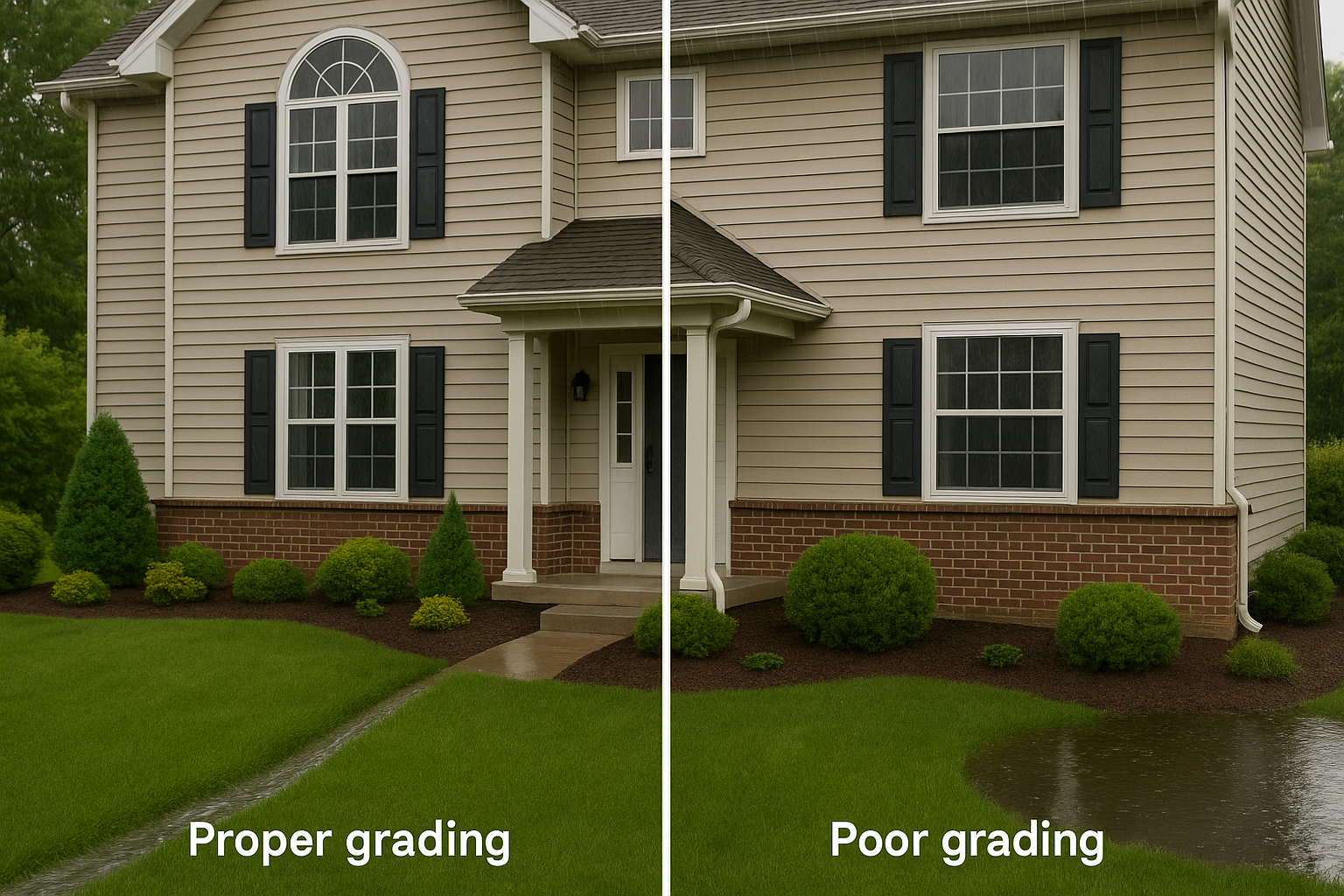Many homeowners focus on fixing leaky gutters, patching foundation cracks, and waterproofing basements after water has already entered the home. What often gets missed is what’s happening outside. The slope of the ground surrounding your house may be quietly affecting your home’s ability to stay dry. An unnoticed dip or pool in the yard can send thousands of gallons of water straight to your basement. In this article, see why the way your yard is shaped, graded, and maintained has a dramatic effect on foundation drainage and long-term water damage prevention. Spot problems early so that a small adjustment can save you major expenses down the road.
What Is Yard Grading?
Yard grading refers to creating a gentle slope of soil or ground that steers water away from your house. The ground should rise up at the foundation and slope down, leading water away. The goal is simple: direct all surface water, rain, and runoff far from your foundation. Proper yard grading protects your house and prevents expensive repairs to both the foundation and basement.
Imagine a rainfall that soaks your yard. If your lawn is flat or dips toward the house, water will sit and seep down the side of your foundation. This excess moisture can erode the soil, put pressure on the walls, and eventually trickle into your basement. Establishing the right slope is one of the most important actions you can take outside to guard your home inside.
The ideal yard grading slope is about five percent. That equals about six inches of drop over the first ten feet from your house. Anything steeper can cause erosion, but less can allow water to pool where it causes damage. Most residential yards should have a drop between three and twenty-five percent depending on site conditions. If the ground slopes toward your house instead of away, or the slope is not steep enough, regrading is the best solution.
Why Proper Yard Grading Matters for Foundation Drainage
When it rains, water always finds a way to travel downhill. If the yard grading around your home is incorrect, water will take the path of least resistance which may send it straight to your foundation. Over time, this invites major risks including a compromised foundation, basement leaks, and even ongoing mold development inside walls.
Water that sits by your home’s base does more than just cause muddy soil outside. As moisture builds, it can push against foundation walls, seep into basement cracks, and shift the ground supporting your home. This leads to both small and large cracks, uneven settling, and eventually flooding that can destroy finishes, furniture, and valuables stored below ground.
Good grading combined with effective downspout extensions, dries out the area closest to your foundation. Dry soil is far more stable than saturated dirt, which shifts, sinks, and puts unpredictable stress on your home’s supports. By diverting water away, you make the environment around your foundation safer in both the short and long term.
Common Signs of Poor Grading Around the Home
Spotting trouble with your yard’s grading early will keep water away from places where it can cause harm. Observant homeowners may catch issues before any major damage happens. Look for these warning signs:
Water pools or puddles beside your house soon after rain. This is usually the most obvious symptom and almost always means improper grading or drainage has occurred.
Your lawn is soggy, spongy, or doesn’t dry out. If the grass around your foundation stays wet long after rain ends, the yard may not be moving water away efficiently.
Cracks appearing in your foundation, particularly horizontal or step-shaped lines on basement walls, often point to building pressure caused by constant moisture in the surrounding soil.
Experiencing even minor basement flooding after storms can indicate trapped water around your foundation. Over time, this can worsen every season as the grade settles further.
Rust, mildew odors, or mold on basement walls should not be ignored. These problems thrive in wet conditions and strongly suggest moisture is entering from the outside.
How to Check Your Yard’s Grading
Want to know how your yard slopes? You do not need complicated equipment to check. There are simple ways to spot drainage issues.
Stand at various points around your house after a heavy rain. Look for areas where water stands or pools along your foundation. These spots signal the ground may be graded incorrectly and needs adjustment.
For a hands-on check, grab a line level and a measuring tape. Place the end of the tape at the base of your house and extend it straight out for ten feet. Use the line level to keep it straight and measure the drop from the starting point to the end. The difference should be about six inches over ten feet for most homes which achieves the ideal five percent slope.
Walk your property and scan for dips, depressions, and flattened areas near the house, these collect water easily. Even mulch beds or low spots in garden beds positioned right next to your foundation can make water back up toward the basement. Keep an eye out for newly compacted areas or changes in soil height especially after heavy rains or construction work.
Common Mistakes When Tackling Grading Yourself
Many homeowners want to solve grading problems without outside help, but certain mistakes can set your efforts back or even create new issues.
An insufficient slope is the most common error. Scraping away a bit of soil usually is not enough. If the drop-off from your foundation to the yard is not at least a few inches over several feet, gravity is not working in your favor. Water will still collect at the house.
Blocking off natural water escape routes with new flower beds, rock borders, or small retaining walls can hold in moisture. Installing decorative features without planning for where water needs to flow can act as dams, forcing water to collect right up against your house. Every hard barrier built adjacent to the foundation should include ways for water to pass through safely.
Another big problem is poorly placed or short downspouts. If downspouts funnel rain from your roof and dump it right at the corner of your home, they only shift the problem from up above to underground. Extensions should carry water at least five feet from the foundation, ideally on a downward slope. Avoid letting any runoff from your roof spill close to where basement walls connect to the surrounding soil.
Do-it-yourself grading fails when the homeowner forgets to account for neighboring lots or impermeable surfaces like driveways and walkways. Make sure water leaving your property is flowing away in a direction that will not cause problems for you or your neighbors. Concrete, patios, and hardscaping collect and direct water too.
Long-Term Risks of Ignoring Yard Grading
Unaddressed grading problems can spell trouble for your home’s future. When water repeatedly seeps into soil next to your foundation, that area never gets a chance to dry. The soil swells then shrinks with each season, shifting your house out of level. Cracks open up in concrete, brick, and block. Mold and mildew seeds itself in hidden corners, fueling rot and foul odors.
Persistent moisture seeping through concrete or block walls leaves telltale stains, flakes, and salt deposits known as efflorescence. Over time, the damage may spread not only to finished basement spaces but also to framing, plumbing, and electrical systems inside those walls. Repairing flood damage or reversing structural movement can be far more expensive than fixing a slope issue in your yard early on.
Beyond physical damage, living in a damp basement increases allergy issues and respiratory problems for your family. Insurance companies sometimes deny water damage claims if poor grading is found to be the cause. Catch problems now so you avoid frustration when you need help the most.
Effective Techniques to Improve Yard Grading
Regrading a yard involves more than just moving dirt. A basic process for correcting your yard’s slope starts with removing any mulch or surface debris a few feet around the house. The next step is digging out soil to create a smooth, regular slope that gradually drops away from the foundation. Good topsoil should then be added and tamped down to set the shape.
Professional equipment may be used for bigger projects, but for small jobs near a single section of the home, shovels and wheelbarrows usually suffice. Once the grade is set, consider installing grass or sturdy groundcover plants to hold the soil in place and reduce erosion. Mulching helps, but be sure it does not act as a water reservoir. Keep all organic material at least six inches below your siding and avoid piling up mulches or stones against the foundation itself.
Rainwater must move freely from the roof to the ground without collecting at the house. Use downspout extensions, splash blocks, or even buried drainpipes to direct runoff well away from the walls. Where needed, professionals might recommend French drains or surface drains to collect and redirect larger volumes of water. Always finish by monitoring the new slope during the first few storms and readjust as soils settle.
Other Ways to Protect Foundation Drainage
Correct grading works best when combined with other protective steps. Make sure gutters are kept clean every season to prevent blockages that spill water over the sides. Regularly check downspouts for leaks, disconnected joints, or corrosion. Grade maintenance goes hand-in-hand with extending downspouts, especially on larger or older roofs.
Permeable paving stones or strategically-placed gravel beds can encourage quick water movement where asphalt or concrete might cause runoff to back up. If you have a retaining wall, inspect it for gaps, leaks, or buildup behind the wall. Add weep holes if water appears to sit behind stones or blocks.
Look for patio and driveway edges that pool water beside the house. Regrading or adding drains along these borders can keep water from reaching your foundation. Fix low spots in garden beds with a wheelbarrow of fresh soil, shaping the area so water moves smoothly to the yard or the nearest storm drain. Routine lawn maintenance, like aeration, also encourages healthy soil structure which improves drainage over time.
When to Seek Help from Professionals
Some yard grading jobs require more than a rake and shovel. If your attempts to correct water issues have failed, the problem may be larger than surface adjustments can fix. Persistent water pooling, recurring foundation cracks, or repeated basement flooding all suggest a need for expert intervention. Water damage restoration specialists, like Austin Hi-Tech Restoration, have the tools and experience to address not just the visible grading concerns but also the underlying drainage and foundation issues that can threaten your home’s structure.
Professionals will evaluate both your grading and other possible factors hurting your foundation. They may use laser levels or surveying tools to determine the best corrective action. These companies can also handle the extra steps if you need subsurface drains, waterproof membranes, or large-scale soil replacement. Most companies offer a complete plan to repair both the yard slope and any water damage already inside. If you have tried fixing the grade and water keeps coming back, call an expert. Protect your investment and get the advice you need before hidden problems cost you much more.
Yard Grading as Preventative Home Maintenance
The shape and slope of your yard is one of the most overlooked factors for home durability. Water follows gravity. Rain will always seek out weak points and let itself in wherever your grading allows. Small investments in regrading offer the best payoff. Protect both your foundation and your peace of mind. Regular checks of your yard’s slope, paired with maintained gutters and long downspout extensions, can save you the shock of water in your basement and costly repairs for years to come. Fix the grade before water finds its way in. Take action now to avoid headaches and hefty bills in the future.


